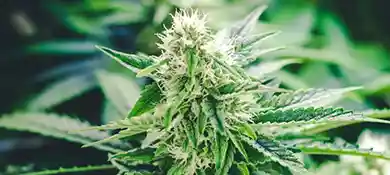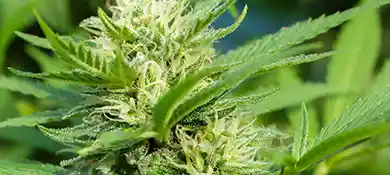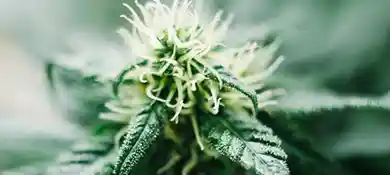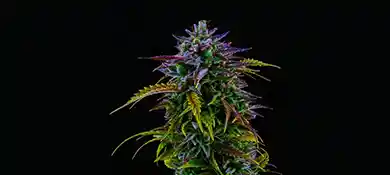How to Control Night Time Humidity in Grow Room
Updated: Oct. 27 ,2025 · 20 min read
In the growing industry, night time humidity in grow room is an issue that few growers concern themselves with. Why does my humidity spike after lights out? What are the hidden dangers of high night-time humidity? Can a traditional dehumidifier be effective during the dark hours? This issue concerns not just the well-being of the plant but also the quality and quantity of its final yield.
This will be the topic of this blog. We will explain what causes humidity changes at night, what threats they might pose and how common methods of explaining it away may fall short. Eventually we will have an optimized and professional solution as well. It can help growers stabilize the climate at night and create a more predictable growing process.
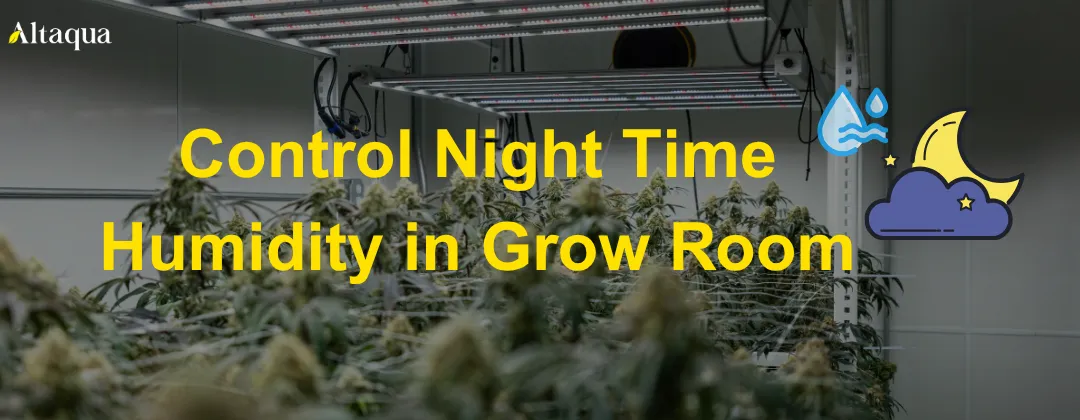
How Does Night Time Humidity in Grow Room Differ from Daytime?
Humidity in a grow room does not stay the same all day. Many growers notice a big difference between day and night humidity levels. After the lights go off, the humidity often rises quickly. In this section, we will look at how humidity changes between day and night in a cannabis grow room.
Typical Daytime Humidity Levels in Grow Rooms
To understand night time humidity in grow room environments, we first need to look at what happens during the day. This helps explain why humidity changes so much at night. Daytime plant activity plays a key role.
Humidity Range During Lights-On Phase
Cannabis plants need different humidity levels at each growth stage. During the day, plants perform photosynthesis and transpiration. These are the main processes that affect humidity. In the vegetative stage, plants grow new leaves and stems quickly. They also release more water into the air. This means humidity can be higher, usually around 40% to 70%, which helps cell growth and nutrient movement.
When plants start to flower they don’t grow many more new leaves. Instead, they put their energy into making flowers. Now, it should be lower — about 40%-to-50%. This depth continues to promote good transpiration, but also helps cut down on the risk of disease.
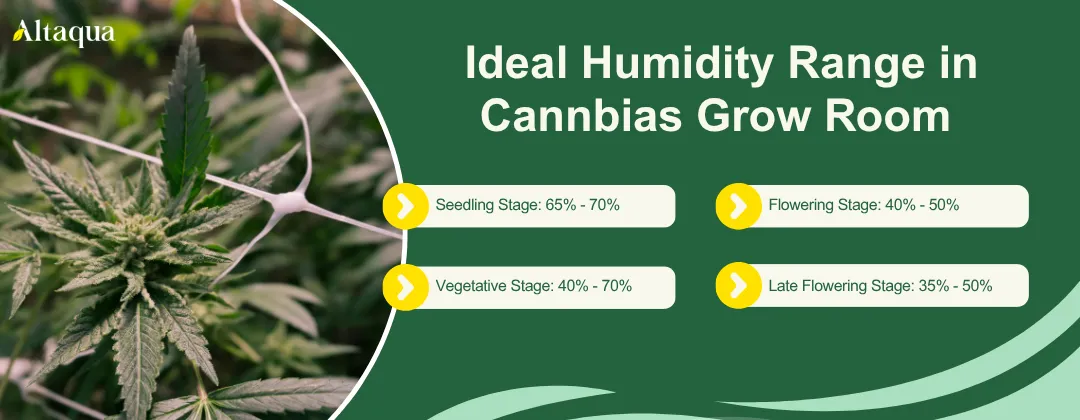
Influences of Light and Plant Activity on Daytime Humidity
During the day, cannabis plants are very active. Once the lights are on, the stomata (tiny openings on leaves) open up. This starts the transpiration process. Water from inside the plant moves into the air. As this water builds up in the grow room, humidity levels rise.
If there are many plants in a small space, even more water is released at the same time. In areas with poor airflow, this can cause moisture to build up in corners or under the canopy. These spots can become hidden humidity risks.
Typical Night Time Humidity in Grow Room
Having already read about how cannabis plants act during the day, we can now review what they do at night. When the lights go out, the plants behave differently. They are also one of the biggest causes of increasing humidity at night in grow rooms.
Observed Humidity Rise After Lights-Off
When the lights turn off, temperature and light levels drop quickly. The plants go into a rest mode. Their stomata close, and transpiration slows down. At first, it may seem like humidity should go down since plants release less water. But in reality, humidity often goes up. This happens because cooler air can hold less water. So, the moisture stays in the air or condenses, and relative humidity increases.
Night Time Humidity Range
Without special dehumidification at night, relative humidity in grow rooms can rise by 20% to 40%, or even more. The exact rise depends on many things. These include the starting humidity before lights-off, the temperature difference between the air and surfaces, the amount of water stored in the plants, and how much transpiration is still happening after lights turn off.
What Causes Night Time Humidity Changes in Grow Room?
We talked about how night time humidity in grow room often rises quickly after the lights turn off. But why does this happen? Is it just because the dehumidifier is not working? Not exactly. The change in night time humidity is caused by many things. It involves changes in plant behavior and how the grow room system controls the environment.
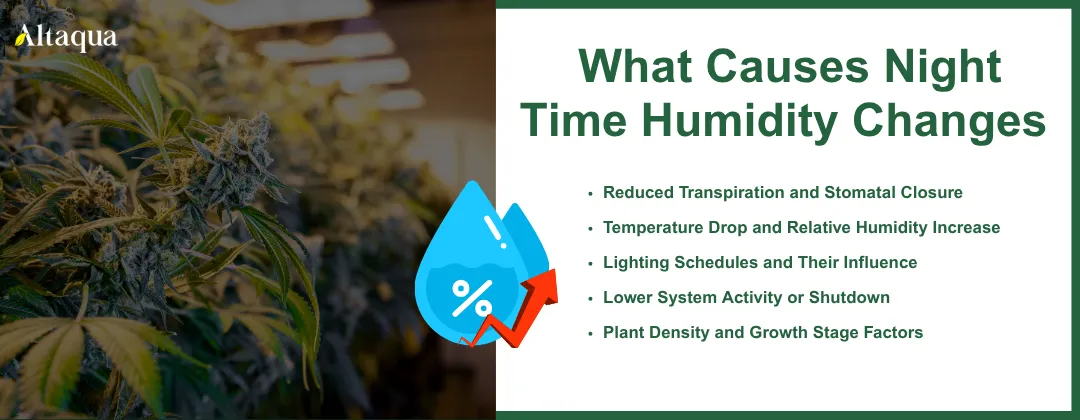
Reduced Transpiration and Stomatal Closure
During the day, plants open their stomata. They take water from the roots, move it to the leaves, and release it into the air. This helps cool the plants and adds moisture to the air. But at night, after the lights go off, the stomata close and transpiration slows down.
Many people think humidity won’t rise if transpiration stops. But that’s not true. Less transpiration means the water vapor stays in the air. The humidity from the day doesn’t leave. If the HVAC system doesn’t increase dehumidification at night, moisture builds up quickly, making the air humid and increasing disease risk.
Temperature Drop and Relative Humidity Increase
Temperature and humidity are closely connected. When the air cools, it can’t hold as much moisture. For example, 26°C air can hold more water vapor than 21°C air. When the temperature drops after lights go off, even if the amount of moisture stays the same, the relative humidity goes up fast.
This is because relative humidity measures how full the air is with moisture at a certain temperature. So, as temperature drops at night, relative humidity can rise from 50% to 75% or higher, even without adding any new water to the air.
Lower System Activity or Shutdown
After lights go off, the heat load in the grow room goes down. Many growers reduce HVAC operation. But in most systems, dehumidification only works during cooling. If cooling slows down, dehumidification slows too.
If there is no separate dehumidifier running at night, moisture stays in the air. Without proper control settings for night time humidity in grow room, humidity can quickly build up.
Plant Density and Growth Stage Factors
The more plants you have, the more water they release into the air. If this moisture isn’t removed during the day, it will collect at night and cause high humidity.
There's also varying growth stages that'll impact humidity. When during vegetative plants transpire more, because the room is filled with moisture through the day. This results in a more rapid increase in humidity during the night. At the late flowering stage, the plant transpires less and water accumulates inside plants. This means it becomes more difficult to deplete humidity in the air, and night time humidity in grow room is more problematic.
What Risks Come with Sudden Spikes in Night Time Humidity in Grow Room?
We have already discussed how reduced transpiration, falling temperatures, and weak system operation can all cause night time humidity in grow room to rise quickly. It may seem like just a small humidity increase, but if it is not controlled in time, it can lead to serious problems. These include plant health issues, system stress, and higher operating costs.
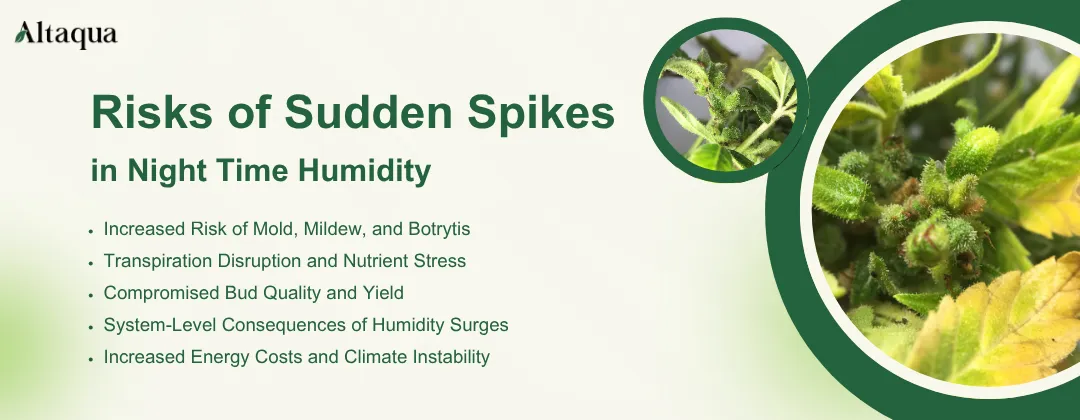
Increased Risk of Mold, Mildew, and Botrytis
High humidity brings a higher risk of plant disease. When humidity stays above 70% for a long time, mold, mildew, and Botrytis are more likely to appear on plant surfaces. At night, airflow is weaker. Water may condense on leaves and buds, making them wet and creating a perfect place for fungus to grow.
Botrytis is one of the most common and harmful diseases in cannabis growing. It often shows up in late flowering. If it spreads, it can lower your yield or even ruin your whole crop.
VPD Imbalance: Transpiration Disruption and Nutrient Stress
High night time humidity in grow room can break the balance of VPD, which controls how plants breathe and move water. In humid air, the difference in water pressure between leaves and the air becomes small. This slows transpiration and makes it harder for plants to move water and nutrients from roots to leaves.
When that happens, plants may become nutrient deprived. You may notice symptoms such as floppy leaves, dried edges or yellowing. Long term it can retard the growth of a flower also.
Compromised Bud Quality and Yield
Flower quality and yield depend on a stable climate. High night time humidity in grow room can hurt flower shape and weight. Moisture in the air can make buds swell and become loose. This lowers their density and dry weight.
If moisture stays inside the buds, it can lead to mold, even if the outside looks fine. Also, high humidity reduces the plant’s ability to absorb key nutrients. This affects the production of terpenes and flavonoids, which lowers flavor, quality, and value. Over time, this may reduce your total yield and profits.
System-Level Consequences of Humidity Surges
When humidity rises fast at night, the HVAC and dehumidifiers must work harder. At night, the cooling load is low, so HVAC systems run less. This also lowers their ability to remove moisture. As a result, systems turn on and off more often. This causes faster wear and reduces efficiency.
Dehumidifiers may still run, but if the humidity load is too high, they must work at full power for too long. That shortens their lifespan. Also, moisture may form on cold parts like ducts, coils, and lights. If water cannot drain out, it may lead to rust, mold, or even electrical risks.
Increased Energy Costs and Climate Instability
If night time humidity in grow room is not under control, systems must keep adjusting. HVAC and dehumidifiers may run at full speed for a long time. Or they may start and stop too often. This wastes energy and raises power bills.
Humidity swings also make it hard to control both temperature and moisture. The indoor climate becomes unstable. This affects plant growth and lowers the overall control accuracy.
The Limitations of Traditional Humidity Control Solutions at Night
In cannabis grow rooms, humidity control is an important part of climate regulation. Many growers still use traditional methods. These methods work well during the day. But when night time humidity in grow room rises quickly, the weaknesses of these systems become more obvious.
What Constitutes Traditional Humidity Control in Grow Rooms?
To manage humidity, growers often use several types of common systems. Each method has its own strengths and limits. Their designs and results are different in practice.
Standalone Dehumidifiers
Standalone dehumidifiers are one of the most common devices. They are often used in small and medium-sized grow rooms. These machines are designed to remove moisture from the air.
They are easy to install and cost less. But they often only cover part of the space. When placed in one corner or side of the room, some areas stay too humid. These are called dead zones.
HVAC Systems
HVAC systems are mainly built to control temperature. Dehumidification is only a side function. It works by cooling the air so that water condenses and drains away.
Ventilation-Based Humidity Dilution
Some growers use ventilation to control humidity. This method brings in fresh air and pushes out humid air.
It can work well in dry seasons or dry regions. But in humid places or sealed rooms, it often fails. It may even bring more moisture inside. Also, ventilation cannot control humidity very precisely. It is not good for dense plant setups or stages with strict humidity needs.
Why Traditional Systems Struggle with Night Time Humidity in Grow Room Environments
We have looked at several traditional humidity control systems commonly found in grow rooms, but most of these systems are designed for daytime conditions. When night time humidity in grow room rises quickly, these systems usually respond too slowly. They also remove less moisture and waste more energy.
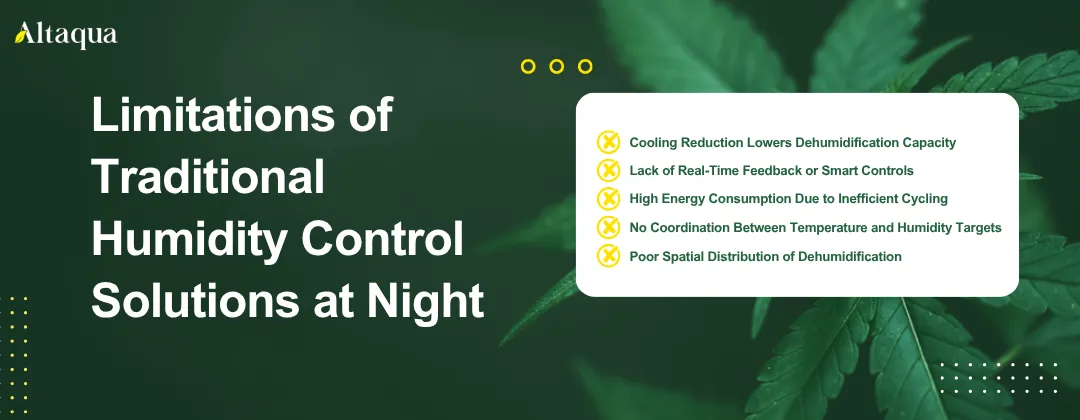
Coupled Load: Cooling Reduction Lowers Dehumidification Capacity
Most HVAC systems remove moisture while cooling the air. At night, when grow lights turn off, the room gets cooler. The HVAC system stops because it reaches the set temperature.
But plants still release moisture slowly. When the air cools, it holds less water. This causes the humidity to rise. Since the system sees the temperature is okay, it does not turn back on. So it also stops removing moisture.
Lack of Real-Time Feedback or Smart Controls
Most traditional dehumidifiers follow simple rules. They turn on only when humidity is higher than a set level. They do not adjust based on real-time changes.
At night, humidity can rise suddenly. If the system cannot sense this quickly, humidity stays high for too long. This increases the risk of plant disease. Without smart controls, the system cannot adjust from far away or react to plant growth needs.
High Energy Consumption Due to Inefficient Cycling
Traditional air conditioners and dehumidifiers often work against each other. The dehumidifier adds heat while removing moisture. Then the air conditioner needs to cool down the extra heat again.
This cycle wastes energy. The machines turn on and off too often. This lowers efficiency and raises energy bills. The result is unstable temperature and humidity. That hurts the plants’ growing environment.
Poor Spatial Distribution of Dehumidification
Standalone dehumidifiers or HVAC systems with poor airflow cannot cover all areas evenly. Wet spots often appear in corners, under racks, or between plants.
At night, air moves more slowly. Moisture can stay in these spots and create high humidity zones. Mold may grow there. Without good airflow design, the system may not detect these risks. That makes control harder.
Achieving Efficient Dehumidification with Altaqua Grow Room HVAC System
Traditional humidity control methods have limitations when dealing with night time humidity in grow room environments. To solve this issue better, a modern integrated HVAC system is more suitable for the strict climate needs of cannabis growing.
Beyond RH Control: Dew Point-Based Dehumidification
And in a grow room, checking the relative humidity isn’t sufficient to determine how much actual moisture is in the air. And relative humidity varies with temperature, even if the actual amount of moisture in a body of air doesn't. It can result in wrong decisions.
For example:
At 27 °C and 90%, dew point is at 25.2°C If it goes to 80% (at the same temperature), dew point lowers to about 23.2°C, and if the temperature increases to 30°C but remaining with same RH (90%) despoint will raise again to 28.2°C.
The changes in relative humidity can appear small on the surface. But the relative humidity, and the likelihood of condensation, aren’t always the same. Using only relative humidity to determine whether to dehumidify may lead you to be too slow in responding when temperatures change.
Dew based control of the Altaqua Grow Room HVAC System. It monitors the true volume of water in the air. If the actual dew point is higher than the set dew point, then the compressor activates to dry. It continues to work until the dew point reaches a safe level. This technique is more precise and less influenced by fluctuations in temperature.

Simultaneous Temperature and Humidity Regulation
In a traditional grow room, however, temperature and humidity are controlled by separate devices. These are in incompatible machines. The systems can’t keep up when humidity changes quickly. You can fix the temperature, but you can’t stop the humidity. Or you get the humidity under control, but then the temperature starts to fluctuate. This is difficult to maintain when it comes to the grow room itself.
Altaqua Grow Room HVAC System is all in one. It combines cooling, heating, dehumidifying and air circulation in a single unit. It has four operating modes: Cooling Dehumidifying, Heating Dehumidifying, Temperature Control {Heating & Cooling mode} and Air circulation mode. These settings control temperature and humidity simultaneously.
Grow room humidity gradually increases when the temper goes down at night, and the cooling doesn’t work. Becomes “dehumidify + temperature control” mode. This great mode rids of excess moisture and mods temperature down to the target. Once the temperature goes higher during daylight, the system would switch back to dehumidifying + cooling mode. It sucks out water and it cools the air at the same time. In this way, the system can work from day to night changes and contribute to plant growth in a constant environment.
WiFi Control Provides Easy Access and Control
In grow rooms, fast reaction and easy control are very important. Altaqua Grow Room HVAC System has WiFi control. Growers can use the internet to check the system anytime. They can see real-time data about temperature and humidity. They can also change settings even if they are not in the grow room.
This 24/7 online control helps keep the system running well. It also saves time and lowers service costs. If humidity levels are wrong or if there is a system problem, the unit sends out a warning. This helps the grower take quick action before the problem gets worse.
The system also works with Modbus protocol. It can connect to a building management system (BMS). For large grow rooms or big projects, this makes control easier. It also helps reduce mistakes and saves labor.
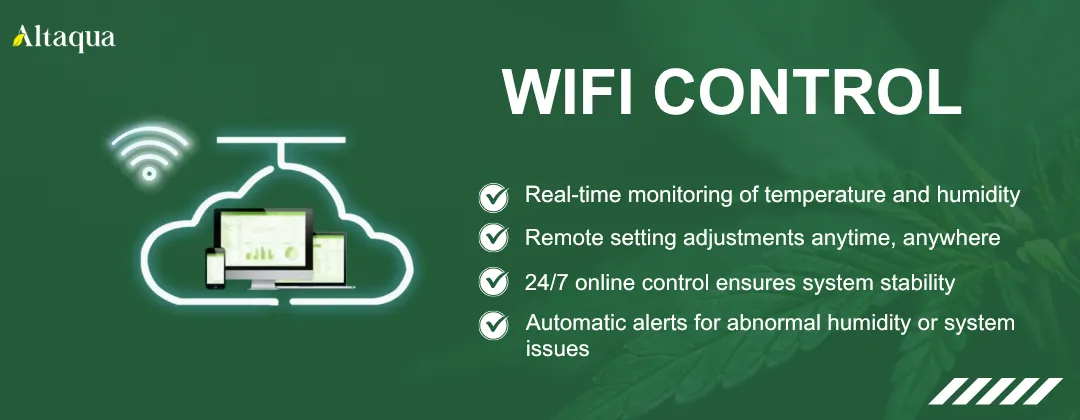
Built-In Redundancy for Mission-Critical Reliability
If a climate system breaks down in a grow room, the plants can be harmed quickly. To avoid this, Altaqua has specially enhanced the "built-in redundancy" capability in the design of the HVAC system in the grow room. Even if one part stops working, the system can keep running and protect the environment.
The system uses separate control circuits. Important parts like EC fans, electrical controls, and compressors each have backup units. If one circuit fails, the others keep working. This design makes sure the system is stable, even if problems happen at night. It helps control night time humidity in grow room spaces without interruption.
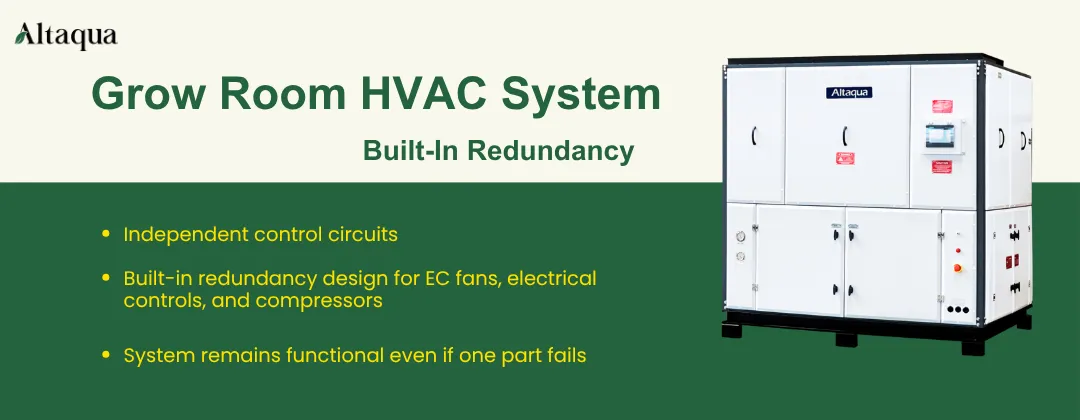
Conclusion
Humidity at night in grow room situations is generally underestimated. But it is an important element for healthy plants. By learning how humidity works, not pushing the limits of old systems and with smart efficient climate control, growers can manage the night time better. This serves to protect the plants and also enhances quality and quantity.
FAQ
1. Why does night time humidity in grow rooms increase after lights go off?
When lights turn off, air temperature drops, reducing its ability to hold moisture—this raises relative humidity. At the same time, plant transpiration slows, and HVAC systems often reduce cooling, leading to less dehumidification. These combined effects cause humidity to rise at night.
2. What is the best humidity for cannabis grow rooms at night?
The best night time humidity in a grow room will depend on the stage of growth. 50-60% RH is generally best during veg, whereas flowering will want lower humidity in the 40-50% range to prevent mold and botrytis. Rapid increases above this level, especially over 60%, can pose significant plant health problems.
3. Can high humidity at night cause bud rot or mildew?
Yes. Excessive humidity at night in grow rooms produce ideal settings for mold, mildew and botrytis (bud rot). Any period of still air, high RH and cool surfaces at night will increase condensation and spore germination, especially late in the flowering cycle when buds are large and susceptible.
4. Why do conventional HVAC systems have difficulty controlling humidity in the grow room during nighttime?
The majority of standard HVAC systems tie dehumidifying to cooling. During evening hours, the lower heat load allows the system to ramp down cooling and thus dehumidification. This ultimately leads to substandard night time humidity of grow room controller. Moreover, these systems do not provide intelligent feedback, humidity-temperature coordination and zone-stratified moisture extraction.
Share with your friends:
Popular Blogs on Altaqua:
Download Catalogue


